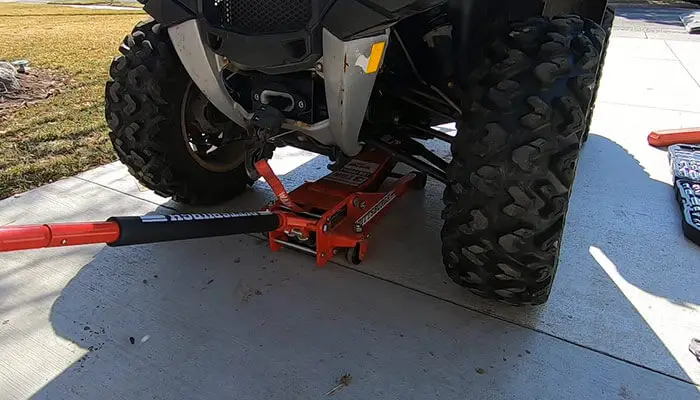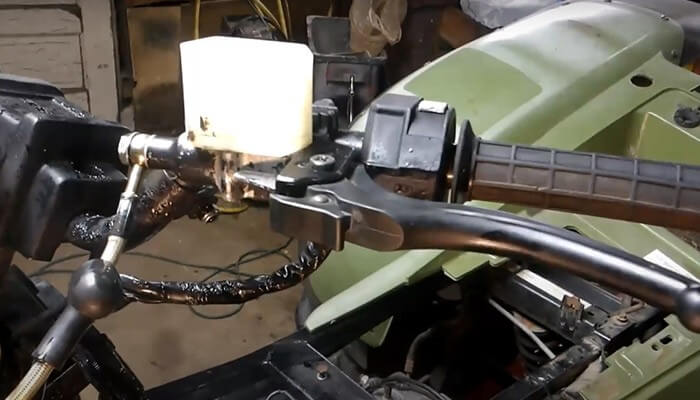Polaris Sportsman Rear Brake Not Working- Fixed
You can confront a lot of difficulties while operating a Polaris sportsman. Among all the problems, you notice that sometimes your Polaris Sportsman rear brake is not working as it should be. There may be numerous explanations for this difficulty.
Why is your polaris sportsman rear brake not working?
Well, Polaris Sportsman rear brakes may not work for many reasons. Failure of the piston-cylinder seals, trapped air, contaminated brake fluid, damaged brake lines, problems in the master cylinder, leaked brake fluids, water intrusion, improper fittings of brake shoes, etc can cause this problem.
That’s only a short outline of the article. Read more to know all the solutions too.
Let’s start!
7 Reasons for Rear Brake Failure + Proper Solutions
There are many explanations for brake failure. But in the case of the rear brake of a Polaris Sportsman, there are a certain number of reasons.

We have discussed them with the solutions below. Let’s learn about them.
Reason 1: Air Trapped in The System
Air can enter the closed brake line structure if you change or detach any of the braking elements in immediate connection with that brake fluid. That’s why it can make its rear brake not work.
Before the brakes can start operating properly, all of the air in the system must be bled out.
Bleeding with the physical approach, no air bubbles will come out. You can also do the same on your 2004 polaris sportsman 400.
Solution
Polaris braking systems are hydraulic, which means they operate using brake fluid. To eliminate trapped air, that fluid may need to be drained or bled.
To bleed the brakes with your car’s manual gearbox, you’ll need a jack, wrench, and wheel nut tool.
You’ll also need someone to hold the brake lever while you use a bladed abrasive tool to bleed the brake lines.
Open the bleeder valve, allow brake fluid to escape, and wait until there are no bubbles coming out.
Clean the cap, then push the lever or foot then pedal a few times to maintain the lever active.
Reason 2: Failure of The Master Cylinder Piston Seals
Rubber piston seals in braking systems spend their whole life in a severely corrosive environment.
If these seals are put dehydrated for further few days, they may acquire knicks, making them unnecessary.
Solution
Hold the moisture of the rubber seals with brake fluid if you’re continuing for parts or executing a crucial repair by making the master cylinder waterless.
When you’re planning a comprehensive repair of an old Polaris or a bike that’s been sitting for a while.
Toss a rebuild kit into your shopping basket alongside the other parts you’ll be replacing. A complete rebuild kit will cost between $10 to $35 and will include:
- A piston
- Piston spring
- E-clip
- Dust boot
- Piston seals
They should be replaced once a year on average.
Reason 3: Contaminated Brake Fluids
The master cylinder will not function properly if the braking fluid becomes polluted or filthy.
Brake fluid will bypass where it shouldn’t due to rubber gaskets and components moving over dirt accumulation, and the piston will be unable to create pressure as it should.
Solution
Remove any old brake fluid with a bleeder. Just upright the bleed valve and pump that brake control until the liquid has drained completely.
Use a brake cleaner and a tiny brush, disassemble and clean the interior of the master cylinder.
The rubber O-rings and gaskets within the master cylinder have most likely been worn out by the filth. Replace these parts with a master cylinder replacement kit.
Replace the master cylinder and brake fluid according to factory specifications (usually DOT4).
Reason 4: Corroded OR Damaged Brake Lines
Brake lines can be damaged when riding off-road because they collide with rocks and trees.
It’s also probable that eroding has grown and is preventing normal flow.
Solution
On a Polaris, the brake lines are normally found on the handlebars.
Always follow the torque guidelines in your owner’s handbook while installing hardware.
Reason 5: Water intrusion or Improper Fittings
Water intrusion into the master cylinder and improper fittings of the brake shoes can also lead to this problem.
Air may remain trapped and you won’t be able to create brake pressure. You should know that this only applies to drum brakes and not disc brakes. So it’s necessary to solve both of these problems.
Solution
For the proper fittings of brake shoes, you should tighten the adjustment until the brake is locked, then back it off three clicks and go on to the next one.
For water intrusion, you need to bleed the brakes. Formerly you can bleed the brakes, the brake shoes on drum brakes must be correctly fitted.
Conduct this procedure on each brake shoe adjuster once – compress the adjustment till the brake doesn’t stop working.
Repeat on all wheels with drum brakes before manually bleeding the brakes.
Reason 6: Leaked Brake Fluid
If your braking system leaks, it will be difficult to produce sufficient pressure. The hole doesn’t t need to be large for you to notice that anything is wrong.
A little leak on a filthy Polaris may be hardly noticeable, with no brake fluid falling to the ground. Only a damp patch exists in the region where the leak is located.
Solution
Examine the brake cables from the master cylinder and at the brake calipers once more. Drag a clean piece of paper down the brake line to help you find any leaking brake fluid.
The hole can be in the master cylinder or calipers. Once again, use a paper towel to locate the leak.
Any damaged parts should be replaced. A master cylinder rebuild kit will be required if there is any hole at the master cylinder or at the brake caliper.
Reason 7: Problems with the Master Cylinder
Sometimes the master cylinder can’t recognize or cope up with the new brake lines. It also can cause this problem.

Solution
When the brake fluid reservoir tier does not seem to be lowering after 10-20 pumps on the brake lever, you will greatly likely want to use a distinct technique to flush the brakes.
In examples like this, you should utilize an easy void bleeder to suck the recent brake fluids from the brake cords.
That’s all. Now you know all the reasons why your Polaris Sportsman rear brake is not working and their solutions too.
If you wish to change the brake pads yourself, it will cost you anywhere from $10 to $60, depending on your Polaris as well as the brand you pick.
FAQs
What type of brakes does a Polaris use?
Polaris uses Sintered Brake Pads. In these brake pads, the pads are of sintered copper and it is competent to provide you special halting strength in wet or waterless circumstances. In conclusion, they are exceptionally strong and become so useful to you. That’s why the brake pads are so special.
Can you repair a Polaris brake at home?
Yes, you can repair a Polaris break at home. All you want are several pieces of equipment and machines. You should have some knowledge about the diagram of the bike too. As it is your first attempt, you should take help from a mechanic. You also learn from him to solve them by yourself next time.
Will I damage my Polaris if I avoid the break periods?
No, things will be fine. Several people vow by the break in moment others will advise you to run it like you have stolen it. I would resist driving broad open and very the throttle for some early rides. But there’s some doubt that the ripping done by you has any negative impact on it.
Conclusion
There you have it. All you need to know about the reasons for the Polaris Sportsman rear brake not working. Now you also know how to fix those problems and stuff like that.
Hope you enjoyed this article and you can share your queries in the comment section.
Have a nice day! Ride free!
- Polaris Rzr No Electrical Power: Quick Troubleshooting Guide - July 17, 2024
- Kawasaki Teryx Vs Polaris Rzr: Off-Road Showdown! - July 17, 2024
- Polaris Rzr Clicking Noise in Rear: Quick Fixes! - July 17, 2024

